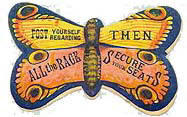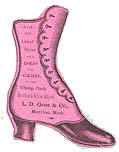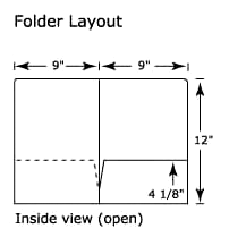

Die Cuts
(See also "Scoring" and "Laminating")
 Definition:
Done after printing as part of the finishing process, diecuts
are areas of the document that are partially or completely cut,
shaped, or cut-out in a variety of shapes. The die is a steel blade
used to punch out the desired shape. Printers often have standard
dies for common cuts. Custom dies can substantially increase the
cost of the piece.
Definition:
Done after printing as part of the finishing process, diecuts
are areas of the document that are partially or completely cut,
shaped, or cut-out in a variety of shapes. The die is a steel blade
used to punch out the desired shape. Printers often have standard
dies for common cuts. Custom dies can substantially increase the
cost of the piece.
Talk to your printer to establish how they want diecuts designated in the digital file. For example, they may request a solid 2 point line outlining the cut of the image or specify a 1/4" or larger edge allowance.
 Also
Known As:
cut-outs
Also
Known As:
cut-outs
Examples: Diecuts include simple slits designed to hold the corners of a business card or the circular cuts to create door hangers. Diecuts on the outside of a piece can allow the text or part of an image to show through from the inside. Diecutting can be used to create rounded corners, flaps, holes, windows, or pop-ups. An entire piece may be diecut into unique shapes. On a page of decorative labels, the diecut may be a circle, rectangle, star, or other standard shape or contour diecuts can loosely or closely follow the shape of the image itself.
Alternate Spellings: die-cuts die cuts
(From: http://desktoppub.about.com/library/glossary/bldef-diecuts.htm)
This is the advice given for planning die cuts from by one printer in an article from desktoppub.about.com
(Recommendations for customers from: Christopher John/The Printworks Inc. @ http://www.cjpw.com)
Giving shape to your project
Think of a shape and it can be die cut! Die cutting or cutting with a die is considered a finishing procedure that is performed after a job has been printed. Simple rectangular 4-sided jobs are final trimmed on a standard "guillotine" cutter and do not have to be die cut. The one important exception to this is jobs that require close registration of printing to the trimmed edge.
 The
two-panel presentation folder...
The
two-panel presentation folder...
requires die cutting, scoring and gluing. You have probably handled a die-cut job without realizing it. Think of the basic two-panel presentation or "kit" folder. It usually has one or two pockets on the inside. These pockets may be just flaps folded up from the bottom (loose flaps) or may be glued on the outside edges, forming a glued pocket. This type job must be die cut using a steel rule die, scored, glued and folded.
Stock die or custom die?
If your job requires die cutting, you need to think about a couple of important issues at the time the art is submitted to CJPW. The first is whether or not a custom die will be required. If so, you must consider who will prepare both the digital art for the outline of the die and the "die vinyl" which will be used to fabricate the steel rule die. You need both to do the job properly. Sometimes, as in the example of the pocket folder above, you may not need a custom die and we may have a "stock" die on hand. Check in advance, as you may be able to configure your job to match a die we have and save time and money.
Die Cutting presses
Most die cutting is done on heavy presses with the "bed" (the area where the dieboard is mounted) either horizontal or vertical. Sheets are fed by hand or automatically, one at a time on the smaller presses, or "stream-fed" (similar to traditional offset printing presses) on larger, automated equipment
Nicking" and stripping
If the cutting edge on a die were continuous, the die cut sheet would fall apart during die cutting, the waste area separating from the rest of the sheet. So several "nicks" are made into the knife edge to keep the sheet from falling apart on press. Afterwards, removing the waste area from the die cut sheet is called "stripping". The small "nibs" along the die cut edge are a result of this nicking process. The size of these nibs can be controlled to some extent but are unavoidable.
Laser die
cutting
Laser
die cutting is a specialized operation, performed with highly
sophisticated equipment. It is normally reserved for long production
runs where its high set-up cost can be amortized by the larger
quantity. Many greeting cards with fine filigree work are produced
on laser die cutting machines.
Steel rule dies
Steel rule dies are made by bending tempered steel cutting rules to conform to a shape on a die vinyl (film positive) and pressing them into grooves cut into a plywood base. Costs for dies vary depending on overall size and complexity. The process usually takes a couple of days and should be figured into your production schedule along with proofing, etc.
(From: http://www.cjpw.com/die.htm)

![]() Electronic
Publishing
Home Page
Electronic
Publishing
Home Page
Department of Communication, Seton Hall University